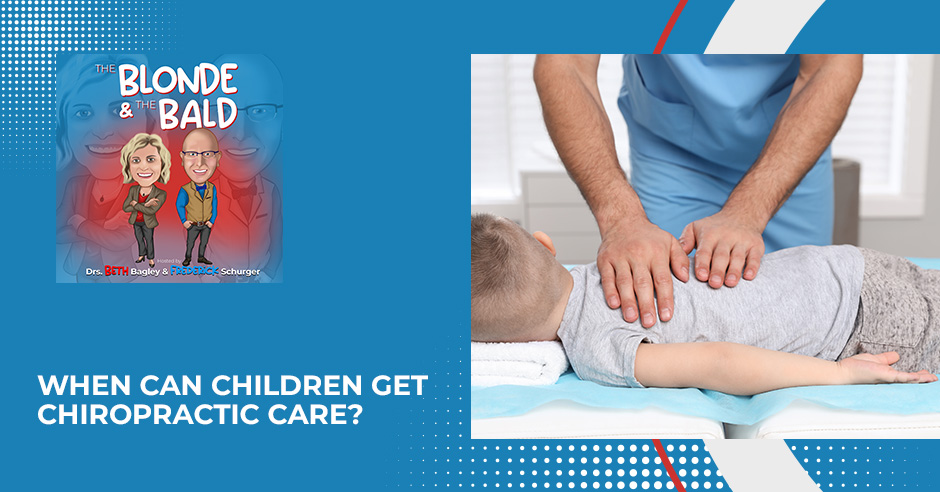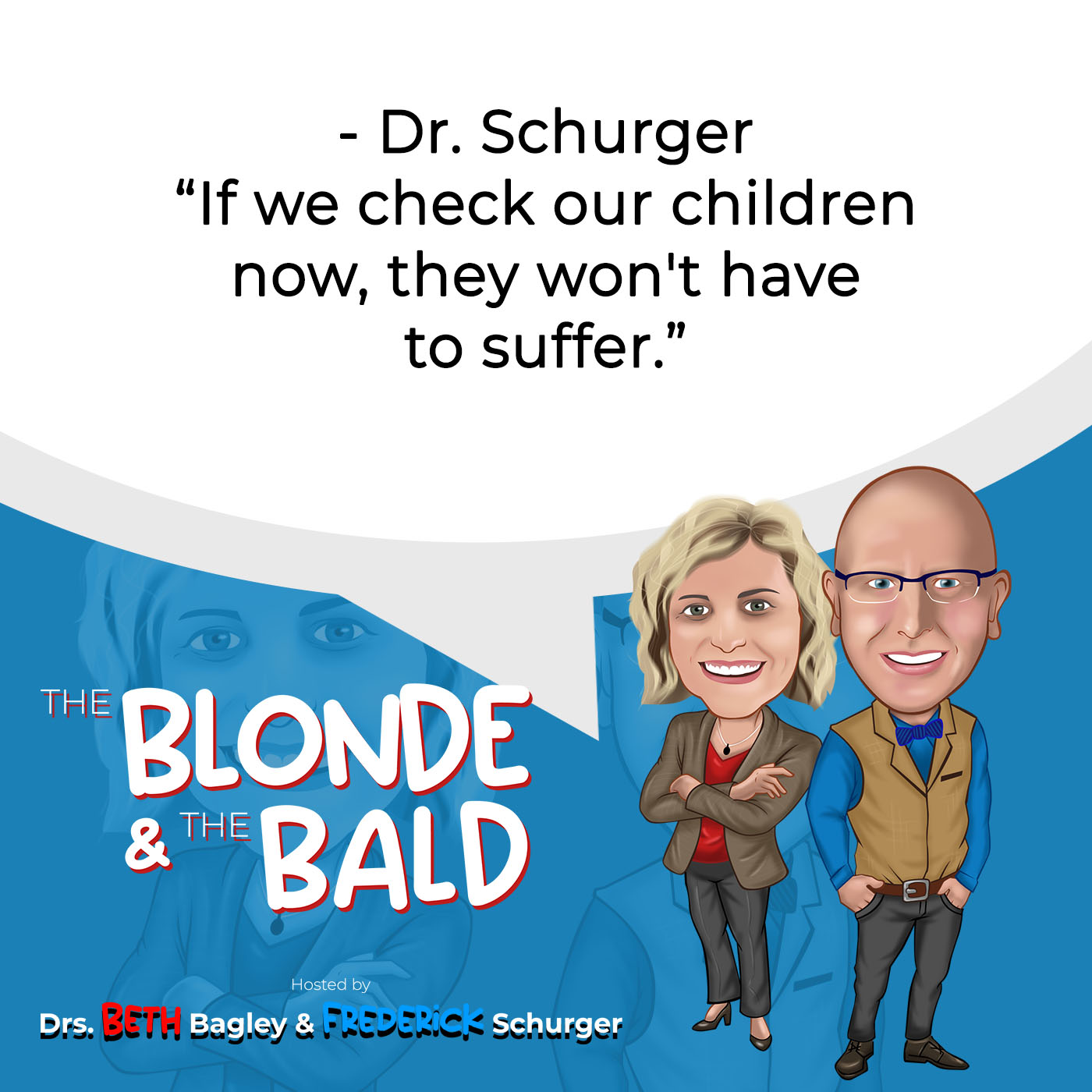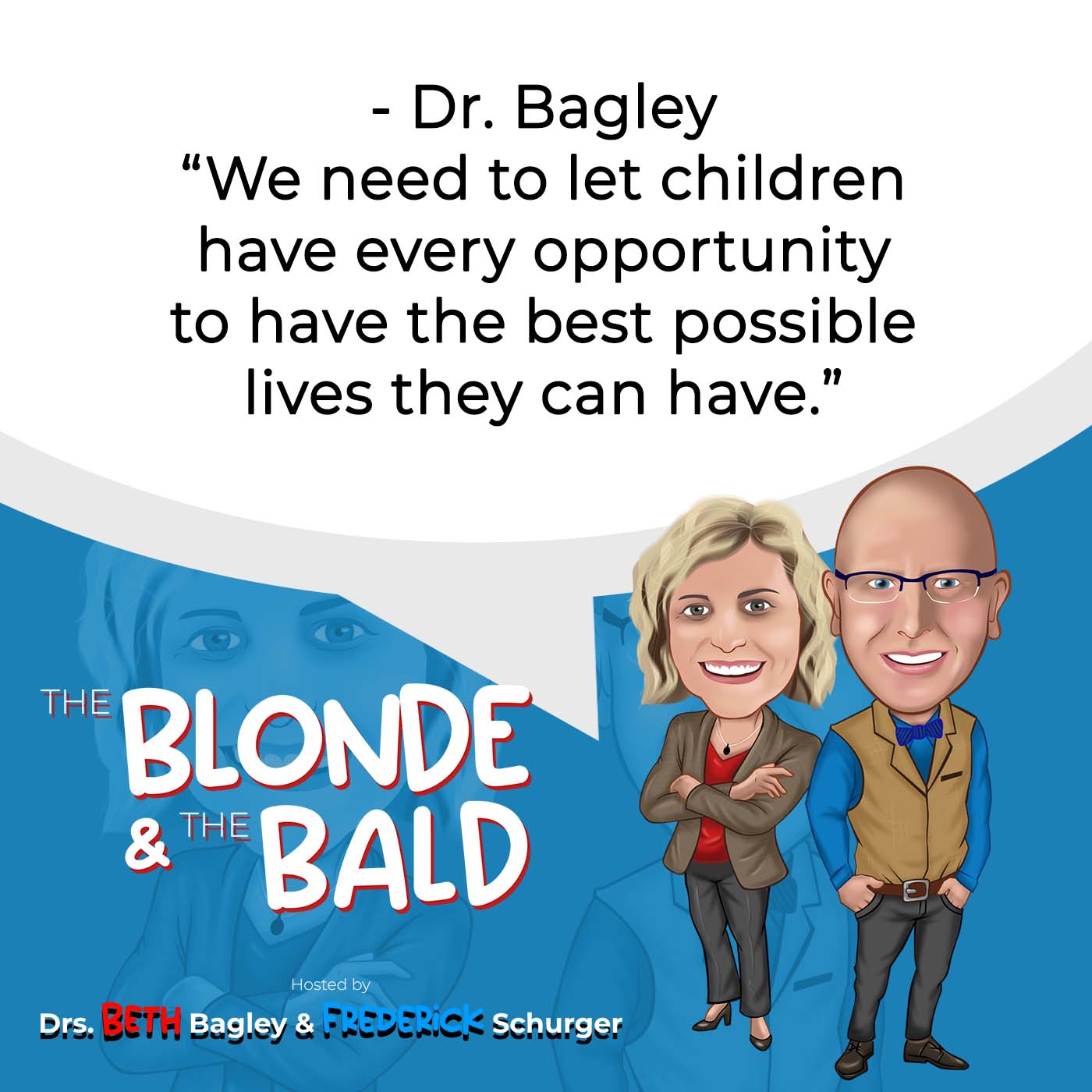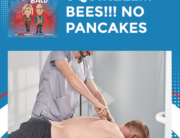
Have you ever wondered if you should get your child adjusted? If you’ve ever pondered whether chiropractic adjustments are suitable for your little ones, this is the definitive discussion you’ve been waiting for. Today, Dr. Beth Bagley and Dr. Frederick Schurger delve into the wonders of Chiropractic, with a special focus on the life-changing benefits of upper cervical care for children. This episode is a journey into unlocking your child’s health potential without resorting to drugs or surgery. You’ll be amazed to learn how even seemingly unrelated health issues in adulthood can often be traced back to untreated childhood traumas. Don’t we all wish we could turn back time and have those issues addressed sooner? Whether your child is facing specific health challenges, or you simply want to ensure their well-being, this episode is your gateway to nurturing your child’s health potential from the early years. Join us now!
—
Watch the episode here
Listen to the podcast here
When Can Children Get Chiropractic Care?
Dr. Bagley, how are you doing?
I’m great. How are you doing, Dr. Schurger?
I’m doing excellent. Welcome to The Blonde & The Bald, Episode 25. We’ve got to this point very quickly and easily probably because we like to talk, we like to talk to each other, and we’ve got great stories or at least you do and I sometimes have a good story that I can interject.
When we were discussing what we wanted to talk about, what came to mind is kids under chiropractic care. A lot of times people are surprised when I have a baby, a toddler, or children in the office and they’re getting checked. They’re like, “Are they here with their parents?” They get checked too. We get questions like that. I wanted to bring up common things that happen to kids that could cause subluxation or a misalignment in the neck.
Let’s go back one step. Even before that, I was asked a similar question. I’ve got a patient. He and his wife have seven kids. He said three are adopted. He said, “How young can we start them?” I’m like, “Let them be born first and bring them on over as soon as mom feels leaving the house.” That’s usually how we like to start, because where is that first trauma? It’s oftentimes birth. One of the arguments is about women have a higher pain tolerance and that’s why women give birth and not men because we would be like, “What comes out from what?”
“We want to push out of what?”
Anyways, I saw a picture of what 10 centimeters dilated is.
It’s unbelievable what the human body can do when properly aligned.
That makes a difference, doesn’t it?
We talk about the first trauma. Even on a so-called normal birth. We’re talking about a vaginal birth where the mom’s pushing the baby. There’s no intervention on the baby. The baby just comes out. There’s still stress on the neck. This is natural stress. A baby’s body is meant to take some of these compressive forces. What a baby’s body isn’t meant to do is the distracted forces. That’s when we get into the interventions that happen. Again, interventions are necessary. I thank God for C-sections and these interventions. We’ve saved babies’ and mothers’ lives doing these.
A lot of times, what we’re missing is who’s checking this child afterward. Their Apgar score is okay after twenty minutes. Great, glad about it. Two days later, when the baby can’t turn their head or tilt to the side, we have something called torticollis. The baby doesn’t latch correctly, or three months down the line, this baby keeps getting ear infections. People aren’t checking what happened with the destructive, pulled-apart forces that happened to the baby when an intervention like vacuum suction, assisted birth, or forceps, which they occasionally still do, and C-section births.
Let’s start with a C-section birth because that’s one I know a lot about because I was a C-section baby. I don’t remember it. I don’t know if that’s pretty common but I do know what a C-section looks like. If you’ve never seen what a C-section looks like, I highly recommend not to look because it’s awful. If you’re interested, you can find videos on the internet.
Again, they put the sheet up because it’s pretty awful. They’re doing it fast. They’re cutting the smallest hole possible, unless it’s an emergency, on the mom, and then they’re reaching inside to the baby’s head if that’s what they can grab, which usually it is. They’re distracting the head up pulling out of mom. Typically, the OB’s fingers are around the occiput of the baby’s head. They’re around the head.
Those destructive forces are not what the baby was meant to hold. Typically, they pull the baby out until they can usually get an arm, and then they’ll pull by the arm. Sometimes I’ve seen them where they pull the whole baby out by their head. Babies are resilient and maybe that baby’s fine, but for a lot of people, that is their first misalignment. I think that was mine.
That’s very well possible. This sounds very gruesome, so we’re not advocating for this. There was a doctor that did a study looking at a bunch of stillborn babies. Again, this is gruesome. Here’s your trigger warning. The question in mind was, “How much force does it take to either decapitate a baby’s head from the body?” They did this test on stillborn children probably back in the 40s and 50s before some of the rules and regulations that exist now came about. That would either cause a decapitation of the baby, which would be the extreme case, or at the very least, a tearing of the spinal cord.
We would call it internal decapitation.
Either way, you’re not coming back from either one of those situations. You’ve got these spring force pulls. Again, I’m sorry because I’m quoting this off the top of my head. It’s been years since I’ve looked at that stat in particular. They were saying that the force was around 110 pounds of pulling pressure to create that kind of decapitation situation. The doctor figures this out in the morgue, and then goes around to all of the OB-GYN docs who are delivering babies and said, “Here, pull it 110 just to get a feel of what it was.” He then asks them, “Compared to that, how much more are you pulling to deliver a baby?” It was commonly said that they were pulling much more. How much, they didn’t test that out.
They could potentially, but still, the question becomes, “Where is that dividing point?” This is why natural birth is ideal. There are two categories, a normal non-traumatic birth, and a traumatic birth type situation. We need to come back and revisit Apgar because it’s been a long time since I’ve looked at that number. I think it’s a 15-point number and you want a higher Apgar score if I’m not mistaken.
The Apgar score is based on a total score of 1 to 10. The higher the score, the better the baby is doing. After birth, a score of 7, 8, or 9 is normal and it’s a sign that the newborn is in good health.
That’s what we’re looking for. Do you have a description of what are some of the things they’re looking for? I know a cyanotic baby or blue baby would be something.
Respiration, crying, reflexes, irritability, pulse, heart rate, skin color, and muscle tone.
You want to see all of those things. Skin color would be an indication of cyanotic, blue, or not getting enough oxygen. What constitutes a normal birth and when does it become a traumatic situation where there’s been a lot of stress on baby and mama, to be quite honest? A C-section is automatically a traumatic birth.
A C-section is automatically a traumatic birth.
This might trigger people too. When we use the word normal, just know we’re not saying that you’re abnormal because you had a C-section. I was born with a C-section. For many people, that’s a route they take, it’s a choice, and sometimes it’s not a choice.
I’m the oldest of my family and my mom did not want to have a C-section, and I was breached the week before. I’m right here, casual because I like gravity. I already knew where gravity was. I didn’t want to be upside down. She walked for the entire week until I turned. She had six of us and she didn’t have to have any surgical interventions for us kids. I wasn’t even the biggest one. My brother Joe, who’s number five, was big.
For my mom, this was 1981. She was an old mom. She was 33 years old. That was considered an old mom back then. Just because she was old, they wouldn’t let her have a vaginal birth. They didn’t give her a choice. They said, “You have to have a C-section.” We’ve come a long way since then, maybe not far enough, but still.
There are mothers in their 40s and 50s that are giving birth sometimes for the first time, which is crazy, but it is a different world than it was back in the ‘80s, that’s for sure. I don’t know about your mom in your delivery, but for mine, Mom and I were in the hospital for about five days. By the time my brother Joe came out in ’86, it was like, “You’re okay? Nothing’s wrong? Go home.” She fought for an overnight for one of them. Either Joe or Jim, one of the last two, she’s like, “No, I’m staying.”
“I need a moment to rest.”
There were 4 or 5 of us at home.
If you’ve had a C-section birth or you were born that way, you’re not abnormal. When we say normal, we’re talking about vaginal, how the body was meant to do its thing. I do agree every C-section birth is a trauma to the baby and the mom because it’s cutting on the mom. It’s something that we need to talk about. We need to check these babies that were born that way. They might be fine.
Honestly, most babies I check are fine, but when they’re not, we check to see how their body is functioning because they can’t tell us that they hurt. They might be upset or something, but they can’t tell us that they’re hurt. We can see symmetry or asymmetries in their face and we can check leg lengths on babies, which is pretty cool.
Sometimes it’s leg lengths. I was taught at one point in time to check the muscles in their lower back. If they’re tight on one side, usually that’s the side that’s drawing up that would normally be a short leg for people. You can then see. You can turn their head left and right like we would do for an adult, and we can feel that melt as they turn their head from one side to the other. That dials us into which side we need to be looking at, at the very least, as a starting point. Oftentimes, especially as a baby, that first adjustment is a push.
It’s so gentle.
All of a sudden, they relax because that’s all they needed.
They relax and poop.
One of my favorite stories is this. I don’t know who told me this because I didn’t hear it from the doctor himself who shared this story. This was Virgil Strang who used to teach at Palmer College for a while. He was president up there and he would always wear a three-piece suit all the time, even throughout the office when he was practicing. He was a Toggle HIO Upper Cervical guy in his practice, but he said, “If you want to practice with children, you have to understand that they are going to burp on you and puke up. They’re going to poop on you and they’re probably going to pee on you.” Sure enough, he adjusts the baby and the baby does all three on his three-piece suit. I understand why a lot of docs like to wear scrubs or very simple clothes.
Why do we adjust or check babies? If we catch a child before their body has processing problems with the misalignment that has occurred, you’ll start seeing, “My baby crawls weird. She just uses one leg. That’s super cute.” No. A chiropractor looks at that and goes, “Why is that baby just pushing off with one leg? Something’s not right.”
That’s 6 or 7 months down the line. I could say even sooner when they’re not sleeping right, they’re not latching to mom for nursing, or they are not pooping right. My buddy’s son didn’t latch for seven months. That seems right, so she never let down. That never happened. What was the next thing? He wouldn’t sleep. He was colicky to the nth degree. Mom and Dad weren’t sleeping either, and they had to drive him around the block until he would calm down. I’ve told this story before in the show. If they stopped or something stopped them on the way back, he’d be back up and up all night. They figured out a system to do it. “Quite honestly, tonight by 9:30, I’m going to be tired. I don’t want to leave the house.”
Parents shouldn’t have to do that.
They were doing this at 10:30 or 11:00 at night.
Honestly, most babies should be asleep by 8:30.
If not, 7:30.
They sleep a long time or they’re supposed to. Some of them will get up to feed once.
These are the early things. It shouldn’t be thought that these are a problem, to begin with, but then, later on, they start crawling weirdly, “Isn’t that cute?”
Every picture you take of this child, they’re so cute with their head turned, but they’re always turning the same way.
It’s always stuck.
That’s not cute.
I’ve got a lot of Amish patients. The first thing I ask the mother is, “How are they nursing on both sides?” Oftentimes, this can be a bigger problem.
They like one side only.
Mom doesn’t like that because Mom needs a break.
That’s because they’ll have problems turning their head. On one side, it’s uncomfortable, so the baby’s like, “I’m uncomfortable on this side. I don’t want to eat like this.”
Also, indigestion and the list goes on. The immune system stuff starts kicking in as early as a couple of months because ear infections will have the potential to plague a child for their entire life. Not to say that any intervention is going to get an ear infection away. Let’s talk facts here as far as ear infections go. When a child has an ear infection, it doesn’t matter if you give them the best chiropractic adjustment ever, antibiotics that don’t work because most of your infections are viral, to begin with, or an antiviral. It’s going to take about 2 to 3 days, usually maybe 4, the offset for the inflammation to die down on its own.
What a lot of the literature is suggesting is, any intervention is not going to solve the problem. It’s going to make the parents feel better when they can give the child an antibiotic. The problem, the research shows that a child who’s given an antibiotic for the ear infection will have monthly ear infections or at least more frequent ear infections right off the bat. Whereas a child that is adjusted, and the one study, they had over 1,000 participants that were looking at these two situations. The children that only got adjusted had very few. They still had them from time to time. There are still bugs and viruses.
Research shows that a child who’s given an antibiotic for the ear infection will have monthly ear or at least more frequent ear infections.
Kids get viruses. Kids get ear infections sometimes, but it shouldn’t be to the point where we’re considering putting tubes in this child’s ears.
Generally, when they’re under good chiropractic care, that starts to reduce significantly. Whereas even the kids who are just under antibiotic care tend to have them very frequently. Even the kids who had antibiotics early on, and then chiropractic still have a little bit of frequency because something in that antibiotic has wiped out some protective mechanism that would have kept that virus at bay.
It begs questions. It gets back to the hygiene hypothesis as to whether or not there are some bugs in our system that we should be having and trying to proliferate, which is why probiotics are so popular these days. The Ortho Molecular has sixteen different probiotic mixes. Lots of stuff going on in those early days and that’s just immune function going on.
If we fast forward, I want to get to some older kid’s stuff because we could talk about babies for the entire show, but let’s move forward.
Quite honestly, some people won’t realize this until their kids are about 5, 6, 7, 9, or 10, and then you start seeing, “Why can’t Johnny sit still in school?”
A lot of times, adults will be like, “I have back pain. I have neck pain.” As a chiropractor, I help people with back pain and neck pain. I remove a subluxation, their body can function well, and the pain tends to go away. Love that, great. Parents will be like, “My kid’s fine. He doesn’t have any pain.” Why is he below reading level? Your kid’s not dumb. Your kid just can’t concentrate.”
Why can this kid not concentrate? Maybe when he was born, his head was ripped to the side or maybe some other things have happened. One of the common things that I see in my office is trampoline entries. Trampolines are super fun. Kids love them. You get two kids going and they smack each other’s head, or they hit the side of the trampoline.
Now, you have trampoline parks where they do all sorts of stupid things. There was one mother. Her son was playing with some of his older cousins. He’s fearless. He was up on the trampoline and his mom heard about some of the stuff that they were doing because he’s 1 and they’re 4 or 5. They’re getting him to bounce higher. Mom’s like, ” I don’t think you’re going to be allowed to play a trampoline with the boys anymore without me there because there’s a certain point where you will find ways to go over that fence.”
If there is one.
There are all sorts of problems. There are lots of fun. I’m not eager to try to hop on a trampoline anytime soon.
As adults, our bodies can’t handle that. Kids are resilient. They’re fabulous. Some kid could smack another kid’s head and be fine, but another kid just because of how they’re made their genetics, the way they hit the exact wrong place at the exact wrong time with the exact wrong head tilt. Now we have a structural shift. That kid maybe cries, and then, “Rub some dirt in it. They’re fine.” Maybe they’re not. Kids can have injuries that can cause problems later in life, even if they don’t have pain right now.
We have to remember that size of a child’s head is 75% of what the adult head will be.
It’s a big old melon head.
Their body has not gone into the adult full adult size yet.
It’s a watermelon on a stick.
If they’re going to have some trauma to the head or even to the body, it could potentially cause a pseudo whiplash that is going to cause all sorts of other problems. I’m thinking off the top of my head. One boy, when he came in, was 7 then. He’s in his 20s this 2023. He had a reverse cervical curve. His head was so far forward. I took a new set of X-rays maybe about 3 or 4 months out, but his curve went back to a normal curve afterward. His grades went up. He was better focused. He’s a boy. Let’s be honest.
Boys are never going to be super focused like that. That’s not how young men are made. They’re not meant to sit still.
One of the arguments about the modern school is well-suited for young ladies and not for young men. It’s a different paradigm shift. There are different needs. We start seeing things. I had another young boy who was big. This is the other thing we have to remember. What constitutes traumatic birth? Long birth. Anything past 4 to 6 hours is a long birth. That’s a lot of pushing on a baby. A petite mother with a big baby, that’s also going to be rough because you’re pushing a melon out.
You don’t notice it until several years later. The next day, Mom kept him home because he still wasn’t feeling great. He says, “Mom, why aren’t the letters blurry anymore?” His adjustment helped his eyes get back to where it’s supposed to be. They were starting to read together. There are so many weird little things that can go on that make childhood miserable.
There are so many weird little things that can go on that just make childhood miserable.
They don’t have the words to express it yet. If they’ve always seen double or something like that, it’s normal for them.
If this blue pen looked orange to you your entire life, you’d have a hard time believing that this was anything but orange or you’d start thinking that everything that is orange looks this color until something got reclassified in your brain. Your entire experience of the world as your neurons are forming and creating your body, we lose more neurons in the first four years of life than we end up keeping long term.
Your body is trying to utilize all of this stuff and it’s setting up your entire body. Your body’s able to function so that you can be a strong contributor to society. People like being around you and you survive childhood. If problems like these don’t get checked and addressed certainly by chiropractic, they’re going to get addressed in other fashions and it’s going to be some medication. What’s the common number of medications given to an adult? I don’t even know. I haven’t looked at the statistics lately.
It’s not uncommon for people who have at least three medications going into early adulthood. Certainly, into the high school years or teenage years. Many people are on multiple medications already. That’s causing other problems. I’m jumping, I’m trying to create a path from early childhood into adulthood because I heard a statistic that suggested that young men are at a significantly high level of contemplating suicide. If not, having it. They aren’t able to make connections with friends. I can’t say what particular thing is causing that, but I’m going, to be honest, they’re medications are not helping that.
Almost 25% of people under 18 are on medication. The last statistic goes through 2018. That’s been a little bit under 25%, but that’s been pretty tip.
Is that one or is that multiple?
It doesn’t give us. It’s just on a prescription drug. I’m sure there are other ones, the stats. If we go 18 to 44, it looks around 30%. 45 to 64, we’re at 70%. 65-plus, we’re in the 80% of people that are on at least one prescription drug.
The question in that under-18 group, I would think birth control would be considered part of that. The question is, 1) Birth control is considered a prescription drug. 2) How many of those people don’t report birth control prescription drugs in that age category? Who’s reporting this statistic is the people who are looking at the medications directly.
I’m looking at asthma medications. That’s another thing. Asthma can be related to a structural shift in the spine too. The point of this conversation in general is why do we want to check kids when there’s seemingly nothing going on with them? The reason I have a passion for it is because we call June, Kid’s Month. Kids get out of school. We promote that we will check kids for free this June 2023. What that means is if a kid hasn’t come in before or if they have, we do a leg length check, do a scan up the back of their neck, and tell the parent, “Yes, I see something going on,” or, “No, I don’t see anything going on.”
Out of the kids that have never started chiropractic care, the majority of them I check is okay. I’ll be like, “Let’s check them in a year again. This kid does not need an adjustment. The kid looks good.” 1 or 2 out of 6 that I check have a huge structural shift and the parent has no idea. I show the parent the leg links. I show the parent the scan, and I say, “I am so glad you let me check your child because this is where they’re at and this is where they’re going to. We can intervene right now and make an impact.”
Honestly, unlike adults, because we are all broken for many years, kids don’t need as much care as an adult. I might only need to adjust them a couple of times in the first couple of months, and I love that. That’s why I’m so passionate because if we check them now, they won’t have to suffer like I suffered. You suffered. I don’t want that for them.
For many years, kids don’t need as much care as an adult.
The one I didn’t bring up was bedwetting.
That’s a big one.

That’s a common one. I suffered from that growing up. When I had my concussion in my snowmobiling accident, this prescription, which is almost the identical prescription that I had 6 to 9 months after that concussion. Who knows? I’m still waiting for my vision to revert back to normal, but maybe I should stay off my phone for that one. I agree. With adults, a couple of times a week to make sure they’re working right. With kids, we need to check them once a month sometimes unless there’s something wrong. Unless there’s something more neurologically significant. The asthma kids and the seizure kids.
I’m going to say this in case somebody’s tuning in like, “What about this?” It was paroxysmal fever disorder. Is that what it is?
That rings a bell.
It was this kid who would get these random fevers. He’s probably in high school or even college now, but he would not be sick. There would be no virus or anything, but he would get this giant fever and the only way he would get out of it is to start taking prednisone. Somewhere on the internet, someone posted something about how their kid was helped by an upper cervical doctor. She found me. This was years ago. The kid went from being out of school 2 or 3 times a month to this happening in the hospital sometimes. After one adjustment, this kid stopped having the fever. We kept checking him and he was holding. I was like, “Finally.”
You’re doing good.
We’re doing good. I was like, “Maybe in six months, let’s check him again or if we notice symptoms coming back.” I’ve been in this location for years. He’s come in once or twice to get checked. He holds his adjustment well, which is awesome. That’s the cool part about it. Where would he have been if his mom wouldn’t have done that research? It’s called periodic fever syndrome, by the way.
I had a young man bring his son in who was probably 2 or 3. The son couldn’t play outside. Can you imagine being 2 or 3 years old and not being allowed to play outside? If you get too hot, you’re going to break down in a seizure. I adjusted this boy. He didn’t have any problems, especially as it got hot. About three weeks later, he had no problems playing outside in the sun. He didn’t have the seizures anymore.
I checked up with the dad maybe about five years later. We’d lost contact along the way. They moved out of the area for a bit. I checked up with the dad and he said, “I haven’t had a problem since. Thanks.” There’s more going on than just saying, “They’re not sick.” No. Losing childhoods. Losing years. This is something that we all have to realize as we come out of 2020 and everything that’s been going on in the past years. Children have lost time. They have significantly lost time.
This is something that we all have to realize as we come out of 2020 and everything that’s been going on the past couple of years: children have lost time. They have significantly lost time.
There’s some developmental stuff that’s going to be weird over the next few years. My brother was telling me about his kindergarten class and they were all bad. Any individual one, they’re going to be fine. As a whole, they were all bad. He had a hard time with them because their paradigm and what they understand about how to interact with the world is weird. Certainly, some of that is the nature of the lockdowns, the masks, and that kind of stuff. How much of it is other health issues that are going on?
Just the chronic stress of what was happening, especially at the beginning of 2020, the kids felt it too. As adults, we tried to keep our kids safe from that feeling and that stress, but it went right into them. Chronic and repeated stress will affect neurologically how a kid is. Add a subluxation to that or maybe that causes a subluxation, that misalignment. These kids have a rough time.
To take any time away from a child, quite honestly, a cardinal sin is what comes to mind.
It’s disgusting.
We need to let children have every opportunity to have the best possible lives they can have. That’s why we’re here. That’s why we do what we do. That’s why we love seeing kids. Like I said, I like to get them in as soon as possible, and then make sure mom’s doing good too.

If somebody’s like, “Who’s the youngest patient you ever adjusted?” I was like, “About four hours old.”
I’ve had a couple of days old. Most of them have been a couple of days old because it’s a matter of, how soon does Mom want to get out of the house?
Some of us will go to them. I’m not against that. I don’t do a lot of house calls. I have for people that have been stuck in places, but I will do that for a baby.
Yes. I don’t disagree with that. They’re a whole lot easier to figure out than an adult.
We don’t need a special table to adjust them. We both utilize a side posture toggle table that has a little clicking headpiece on it. It’s pretty necessary. We have ones that we can take with us places, like headpieces, but that’s not great. Our tables are very necessary for the type of adjusting we do. For babies, not so much because we just use a little finger touch and we can get it into place.
Babies are easier. Young kids are easy. My only problem is kids love me between 0 and 6 months, then something flips from 6 months to about 2 years. I’ve got one young man. He is just over two and he is not happy to see me. I check him as quickly as possible with Mom and Dad helping out. Last time, I’m like, “You’re good.” His tears are still coming, “I’m good? I’m good. Goodbye.”
You never know. That’s just their age. Sometimes when we poke at something, it’s not comfortable for them.
It’s so painful.
They relate that as, “Last time, that doctor poked me. It hurt a little bit. I don’t want to get poked again.” I get it. They don’t understand that we’re trying to help them. There’s a little stranger danger, not a fun time in the toddler years when we see patients. I love the babies. I still love those little kids too, but they sometimes don’t want to be there. Right around 2 and a half to 3, for me, those kids start loving me again. I know that we go into a little cycle.
For me, that 6 months to 24 months, they want nothing to do with me. Afterward, I remember one boy, who holds like a champ. I don’t think I’ve had to adjust him for years. Early on, it was pulling teeth. He did not like me. He’s been holding for years.
He doesn’t like you so much that his atlas is holding in place.
Sometimes I’m okay with that obstinate attitude. In any case, that’s a great place for us to wrap up. Dr. Bagley, where can they find you?
They can find me in St. Louis, Missouri. We’re on the West Side. You can find our website at PrecisionChiroSTL.com.
I am at Keystone Chiropractic in Springfield, Illinois, KeystoneChiroSPI.com. We’re on all the socials as well. We will be back. We might have a slight hiccup in our weekly publications here. For those people who are like, “Where did you go?”
We’ll call it summer break.
It might not be that long, but just so you’re aware that is sort of a game plan we might take 1 week or 2 off before we get back on the road, but I suspect we’re going to have several episodes coming out. As I said, this should come out in July 2023, I believe, and then we’re going to be back in late July, or early August if we’re not back within a week. We’ll figure that out. Don’t worry about it. Enjoy.
Don’t miss us too much.
Do not. We’ll see you soon.
Important Links





